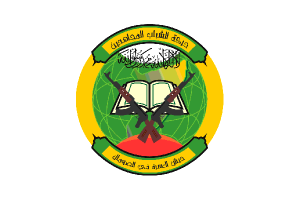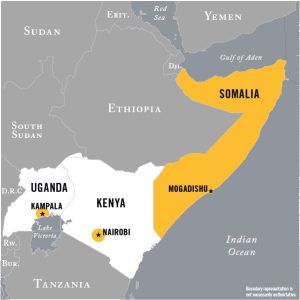This analysis is conducted as part of the Son of Media Safety & Security’s Project on War and Foreign Terrorist Organizations (FTOs). Learn more here.
al-Shabaab
Somalia has been controlled by several different warring clans and warlords since the 1990s. Many Islamic extremists groups also formed during this time. One such group, supported by AQ elements, called the Unity of Islam served as a precursor to the formation of al-Shabaab.
In 2003, Unity of Islam veteran members made moves towards the creation of a political party to accomplish their goals while its “youth” (“shabaab”) members desired a more hard-lined Islamic rule in the “greater Somalia.” In 2004, when eleven Shari’a courts in Somalia joined to form the Islamic Courts Union (ICU), al-Shabaab formed to serve as their armed militia.
- 06/2004: Eleven Shari’a courts form the Islamic Courts Union (ICU)
- 10/2004: The Transitional Federal Government (TFG) is formed in exile
- 06/2006: Backed by al-Shabaab, Mogadishu falls to the ICU
- 12/2006: Ethiopia invades Somalia and retakes Mogadishu
The rein of ICU and al-Shabaab justice began and continued with amputations of limbs for stealing, stoning for adultery as well as killing of non-Muslims. Al-Shabaab forces would reportedly commit beheadings and leave the corpses in streets as a message to encourage conformity. Intimidation and violence continued in many forms including bombings, shootings and assassinations. The violence often targeted women, peace activists, civil and political figures, journalists as well as international aid workers.
In 2006, the ICU with the assistance of al-Shabaab took control of Mogadishu. Six months later, fearing invasion into their nation, Ethiopian forces invaded Mogadishu. The Ethiopian invasion served as a propaganda tool for the recruitment of al-Shabaab forces and also helped create alliances with clans throughout Somalia. As a result, and despite Ethiopia’s future withdrawal, al-Shabaab became the largest force in Somalia, controlling land, funds and weapons, giving it the ability to wage conventional warfare.
Al-Shabaab activities and relevant Somali history has includes:
- 01/2007: The TFG enters Mogadishu
- 02/2007: The United Nations approves the formation of the African Union Mission in Somalia (AMISOM)
- 03/2008: U.S. State Department designates al-Shabaab as an FTO
- 10/2008: Suicide bomber Shawa Ahmed, a Somali-American, kills twenty-four in Hargeisa
- 01/2009: Ethiopia pulls out of Somalia, replaced by AMISOM
- 07/2010: Suicide bombing in Kampala, Uganda, kills seventy-six (one American)
- 08/2010: AMISOM pushes al-Shabaab out of Mogadishu
- 10/2011: Kenya invades southern Somalia
- 02/2012: AQ announces the al-Shabaab pledge of obedience
- 03/2012: Mortar attacks against Presidential Palace
- 04/2012: Suicide attack targets Prime Minister Abdiweli Mohamed Ali at the Mogadishu National Theatre
- 05/2012: Suicide attack at a cafe in Dusa Mareb
- 10/2012: The port city of Kismayo is retaken by Kenyan and AMISOM forces
- 11/2012: Attacks on border city with Kenya
- 06/2013: Attack on UN compound in Mogadishu
- 09/2013: Attack on Westgate Shopping Centre in Nairobi, Kenya
- 02/2014: Attack on Presidential Palace
- 05/2014: Attack on restaurant in Djibouti
- 06/2014: Attack on Mpeketoni killing fifty tourists
A string of AMISOM successes in Somalia have removed many sources of funding and land resources from al-Shabaab. Therefore, its forces have diminished significantly, despite their 2012 affiliation with AQ. Al-Shabaab has moved its tactics back to more asymmetrical means, including the use of IEDs and suicide type attacks.
It is widely reported that although the AQ, AQIM, AQAP affiliations still stand, the Somali clans and sub-clans that make up the bulk of al-Shabaab allies are more interested in internal matters, as opposed to global jihad. Despite this analysis AQ foreign fighters still lead training and indoctrination of recruits. Given this, as well as the fact that there are dispersed Somali communities throughout Western nations, al-Shabaab still remains a threat.
Leadership
- Aden Hashi Ayro: First operation leader, killed by U.S. air strike in May of 2008
- Ahmed Abdi aw Mohamed (aka Abu Zabayi): killed in September of 2014
- Rivalries are currently reported
Goals Overtly Declared
- Formation of a “Greater Somalia” under Islamic rule
Membership (Estimated/Approximate)
- Core force of approximately 5,000, at time augmented by clans
Base of Operations
- Somalia: middle and lower Jubba region, Bay and Bakol regions, northern Somalia near Golis Mountains
Funding Sources
- Illegal charcoal production
- Exports from smaller ports (since the retaking of Kismayo and Menka by AMISOM severely hampered exports fundraising)
- Taxation on locals
- Foreign donations
Marketing Vehicles
- unknown
Also Knows As (AKA)
- The Harakat Shabaab al-Mujahidin
- al-Shabab
- Shabaab
- the Youth
- Mujahidin al-Shabaab Movement
- Mujahideen Youth Movement
- Mujahidin Youth Movement


